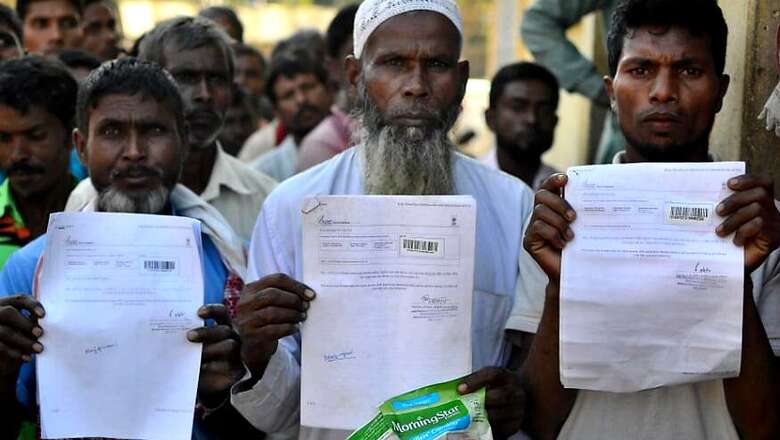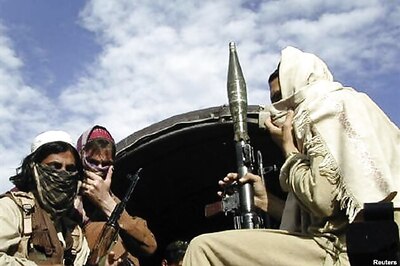
views
In the past one year, or so, especially since December 2016 – when the 1st draft of the National Register of Citizens (NRC) was released – one has seen a huge interest on the issue in national and international media, civil society and multilateral bodies like Office of the United Nations High Commissioner for Human Rights.
It was amusing to see people cherry-picking issues and raising bogeys to suit a narrative of their choice. But it is clear that there is a huge pushback to the process, the foundation for which was laid 33 years ago.
At midnight of 14 August, 1985, people of Assam believed that it was their tryst with destiny. A five-year-old agitation against illegal immigrants from neighbouring Bangladesh had come to an end with the signing of a tripartite treaty between the All Assam Students Union, the Assam Government and the Rajiv Gandhi-led government at the centre.
However, it was a tryst that was not to be. The updated National Register Of Citizens will be published at midnight of 31st July, a move that could be a potential disruptor in many ways.
As someone who was born and grew up in the state, I see the ongoing NRC exercise as a response to long neglected problem, made worse by callousness of policy makers and subservient political leaders who failed the state. Assam Gana Parishad – comprising leaders of the Assam Agitation – had 2 terms in power and yet were not able to initiate the updating of NRC. The Congress government gave it a half-hearted push in 2005 but it was the Supreme Court, which responding to a PIL on illegal immigrants by the NGO Assam Public Works, mandated a time-bound completion of the update of the register.
It is imperative that process of updating the register has to be completed. But it is easier said than done.
Let’s look at the Assam Accord, which is the basis of the NRC updation process. On the issue of illegal immigrants, the accord follows the 3-D spirit: Detection, Deletion and Deportation.
Updation of the NRC is a process to detect illegal immigrants in the state of Assam. Any foreigner without valid entry papers entering and residing in Assam won’t be included in the updated register – which subsequently will lead to rescinding of their Indian Citizenship .
Incidentally, in all other parts of India, the cut-off date for Indian citizenship is July 19, 1948.
The process of detection of illegal foreigners was also carried out through Foreigners Tribunals – special courts – which would take up complaints against alleged illegal immigrants. The tribunals made several blunders, leading to allegations of bias.
Questions are also being raised on the fairness of the NRC updation process as new ground rules got added midway. It is well established that any big ticket government scheme will have unintended implementation issues. However, any serious doubt on fairness of the national register of citizens will mean that the exercise will lose credibility and that will create issues which will be hard to tackle in the future. No genuine Indian citizen – as established by the Assam Accord of 1985 – should be left out from the register.
Let’s jump to the third D on the list – Deportation. The Assam accord seeks to deport any illegal foreigner – in this case Bangladeshi immigrants entering Assam illegally after 25th march 1971. A majority of people in Brahmaputra Valley – especially in middle and upper Assam will tell you that this date is non-negotiable and all Bidexis (illegal Immigrants from Bangladesh) have to be sent back.
One has to understand that this is rather impossible. While deportation was a solution that Assam Agitation sought to suggest, the student leaders of the movement didn’t understand that it is a matter contingent on bilateral agreement between India and Bangladesh.
In a seminar organised on NRC in June (which this author was a part of) former Home Secretary Gopal Krishna Pillai shared that deportation of immigrants without valid papers was raised by India in several meetings with Bangladesh and every time, it was rejected by the neighbouring country.
So what does one do with people whose name doesn’t get included in the register? This question has haunted millions in the state and the government has not been clear in communicating the way forward.
Estimate of people being excluded from NRC range from 50000 to 4 million. Will such a large number of people be sent to detention camps? Currently there are six of them with reports of appalling living conditions. Will children be snatched away from their mothers? Will grandparents be forced to live the rest of their lives inside barbed wire compounds? Needless to say, the gargantuan Human Rights crisis that such a move could generate will be impossible to defend.
Yet one has to swallow the bitter pill and ensure that a one time cleaning process gets carried out. Illegal Immigration in to Assam is a problem and this can’t be swept inside the carpet. To make matters worse, Many have started adding communal colour to the process.
A section of nay-sayers allege that only Bengali speaking Muslims are being targeted through this process. Clearly they are ignoring the fact that a large chunk of illegal immigrants from Bangladesh are Bengali speaking Muslims. They have also ignored the fact that a significant number of Bengali speaking Hindus also are under scrutiny and won’t see their names in the updated NRC.
The current ruling party at the centre – the BJP – added one more layer of complication by proposing to introduce a bill that seeks to facilitate Indian citizenship of minorities in neighbouring countries. This meant that Bengali speaking Hindu illegal immigrants from Bangladesh residing in Assam will be able to secure their citizenship. While the proposed legislation apparently has been shelved temporarily, it has not been buried and can be potentially used as a political dole to garner votes. Power corridors in Delhi are also abuzz about plans to grant long term visas to Bengali speaking Hindus.
This bill has already created a polarisation between the predominantly Assamese speaking Brahmaputra valley and the Bengali speaking Barak valley comprising the three districts of Cachar, Hailakandi and Karimganj. There were widespread protests against the bill in Brahmaputra valley while in Barak, it was exactly the opposite.
This brings us to the Second D – Deletion. The Assam accord seeks to delete names of illegal immigrants from the voters list. Taking away voting rights of Illegal Immigrants detected through an established process is a logical next step in any democracy.
In an interview to web news portal Wire early this July, former DIG Hiranya Kumar Bhattacharya said that Assam had missed the Bus with respect to deportation. These words come from a person, who as a cop had first raised the issue of illegal voters in Mangaldai – which acted as a spark of the Assam Agitation.
As a sustainable solution, several experts – including Meghalaya Chief Minister Conrad Sangma - have proposed to give special work permits to people whose name did not make it to the register.
On 30th of July, when the Assam Government comes out with the updated NRC, it will be the start of another journey – one that will not end soon.
That’s because there will be a process of claims and appeal – through which people who were left out will be given one more chance to produce documents to prove that they or their ancestors were Indian citizens before the march 1971 cut-off date. Clearly, many who are excluded will move court.
Last but not the least, there are multiple cases that the Supreme Court and the High court are hearing. One of them before the Supreme Court – filed by Asom Sanmilita Mahasangha – that challenges the March 25 1971 cut-off date and seeks to push it back to 1951 – which is applicable to all Indian States. If the Constitution bench agrees to this petition, it will reboot the entire NRC updation process.
Whatever the case may be, people of Assam – from both the valleys - have a lot to learn from this experience. People of the state must understand that their biggest strength is diversity. Unless this diversity is celebrated, the future of the state will continue to be in peril.



















Comments
0 comment